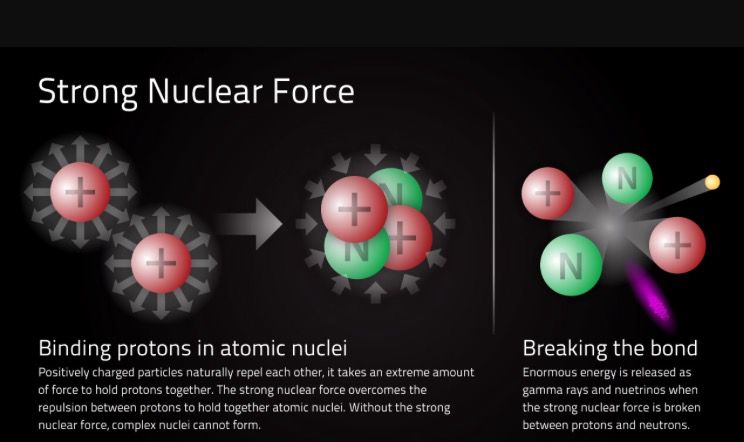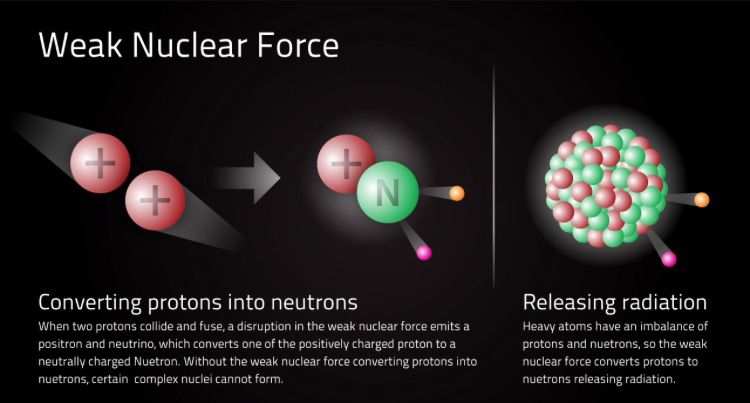Nuclear forces
Nuclear forces
The four fundamental forces of nature are; electromagnetic, strong nuclear force, weak nuclear force; and gravity. We're familiar with electromagnetism and gravity, but what about the nuclear forces.
Let's start with the strong nuclear force because it's what makes our atoms possible. As you know, an atom is composed of a nucleus with protons and neutrons orbited by electrons. The protons and neutrons are collectively called nucleons. Protons have positive charges while neutrons are neutral. That makes sense.

Now think about this. What kind of force would it take to hold protons together? The answer is a very strong force. They have positive charges and thus normally repulse. What's really strange about the strong nuclear force is that it's only effective at close distances. Normally, protons repulse until they get very close and then attract. This sounds like magic, but it's very important to understand how this works.
Neutrons, by the way, provide the force to hold protons together. They are cops of the atomic nucleus and keep the protons in line, but you can only pack so many neutrons in an atom's nucleus before the atom fissions. So, how do you get two nucleons to stick together?
The answer is called fusion, and what happens is that when two nucleons approach they repulse, but after they are at a close distance, they exchange mesons (composed of one quark and one antiquark held together by strong force). When this happens they attract. Think of it this way. Two angry men approach each other. They both have swords and are prepared to fight. As they approach, the anger between them increases and they swing their swords more violently. However, when they get close enough they decide not to fight and exchange their swords as if they were gifts. Now they can hug, and when they do, they're happy. This is the way that nucleons are melded together in the nuclei of atoms during the fusion process. It's the exchange of mesons that makes it possible. This strong force acts like a glue to hold the protons and neutrons together. In fact, the particle responsible for it is called a gluon. Those physicists are jokesters!
A meson is a subatomic particle made up with one quark and one anti-quark held together by the strong interaction (another name for the strong nuclear force). They are short lived and decay to photons if they're not charged. These mesons are exchanged by two approaching nucleons like Ping-Pong balls are exchanged between two players. As long as this exchange happens, the strong nuclear force can hold the two nucleons together. However, for this gluing together to happen the two nucleons must be moving very fast at high temperature, such as in the core of a star or in a hydrogen bomb.
Neutrons are easier to glue together and they help provide the strong force to hold protons together in an atom's nucleus. This strong nuclear force is what holds our atoms together. Without it we wouldn't exist. This is obviously a simple explanation for something much more complicated.

What is the weak nuclear force (interaction)? This is a force that is stronger than gravity but only effective at short distances. In other words, it operates at the subatomic level. It has to do with the natural radiation, such as beta decay. This is where a neutron in the nucleus of a radioactive element changes into a proton and emits an electron (beta particle) and an anti-neutrino. This weak nuclear force allows the Sun to fuse hydrogen into helium and is responsible for the energy in the form of gamma ray photons that's produced. Without this weak nuclear force, the Sun would go out.
The weak force is caused by the emission or absorption of W and Z bosons. W bosons are intermediates of neutrino absorption and emission. Z bosons mediate momentum, spin and energy when neutrons scatter elastically from matter. Basically, they carry the weak force.
To explain these forces using particle physics terms would be too confusing. Suffice it to say that the strong and weak nuclear forces are important to an understanding of what we're made of and how things work. You can think of it this way: What the strong force joins, the weak force tears apart. Sounds like a divorce after a marriage.
Thanks for reading.
Bạn đang đọc truyện trên: Truyen247.Pro